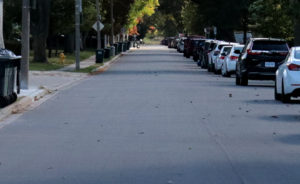Low car traffic leads to better air quality

Personal vehicles line Windermere Road in Windsor, Ontario. Photo by Zachary Balogh
Countries who experience high levels of poor air quality have seen noticeable drops in pollution since the start of the global pandemic.
The novel coronavirus has had various impacts around the globe. One of those impacts is strict stay at home orders. These orders halted travel in most countries last spring. More people staying at home is believed to have led to a decrease in air pollution. Less pollution equals better air quality, according to the United Nations Economic Commission for Europe.
After stay at home restrictions were put in place, motor vehicle traffic dropped, leaving the streets eerily quiet. This led to a decrease in traffic–related emissions such as carbon dioxide and nitrogen dioxide. These emissions contribute to poor air quality, according to C&EN Global Enterprise.com.
Many other countries have been observing the same drop in emissions according to the World Economic Report. The standout was in northern Italy where there was a significant reduction of nitrogen dioxide.
China also observed a drop in nitrogen dioxide. NASA reports that levels there this year dropped 10 to 30 per cent lower than they were last year. Chemical and Engineering News Magazine reported that other countries such as New Zealand saw an 80 per cent drop in traffic during the height of the pandemic. Researchers are still analyzing the data to determine the effect on air quality.
In Canada, Nadia Matos, a media and public relations consultant at the Canadian Automobile Association, said its insurance data pointed to a decrease in vehicle traffic.
“Based on the data, driving was down 50 per cent from this time last year,” said Matos.
Air pollution causes seven million deaths worldwide every year, according to the World Health Organization. It is a more serious risk for individuals with asthma, allergies and chronic obstructive pulmonary disease.
As travel restrictions now begin to ease in some communities, there has been a slight rise compared to other cities that did not have the same protocols.
“In places where the restrictions were eased the traffic started to pick up again and the pollution started to increase,” said Dr. Jean Pierre Charland, Environment Canada’s Manager of the Environment of Climate Change Canada’s (ECCC) Analysis and Air Quality Section.
Those who have been enjoying cleaner air may find the growing traffic makes it harder to keep breathing easy.


